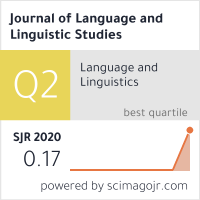A frame analysis of the language used by eight US media to describe the role of China and Chinese in spreading Covid-19 during late January to early June 2020
Abstract
Keywords
Full Text:
PDFReferences
AFP. (2020, June 21). China bans some US chicken, shuts Pepsi plant to fight coronavirus. Retrieved June 22, 2020, from Economic Times: https://economictimes.indiatimes.com/news/international/business/china-bans-some-us-chicken-shuts-pepsi-plant-to-fight-coronavirus/articleshow/76495088.cms
Baran, S. J., & Davis, D. K. (2000). Mass Communication Theory: Foundation, Ferment, and Future. USA and Singapore: Wadsworth Thomson Learning.
Bier, L. M., Park, S., & Palenchar, M. J. (2018). Framing the flight MH370 mystery: A content analysis of Malaysian, Chinese, and US media. International Communication Gazette, 80(2), 158-184. doi:10.1177/1748048517707440
Boykoff, J. (2012). US media coverage of the Cancun climate change conference. PS: Political Science and Politics, 45(2), 251-258. doi:10.1017/S104909651100206X
CNN. (2020, May 10). Coronavirus Has Created a Rift Between US and China That May Take a Generation to Heal. Retrieved June 22, 2020, from News 18: https://www.news18.com/news/world/coronavirus-has-created-a-rift-between-us-and-china-that-may-take-a-generation-to-heal-2613537.html
CNN. (2020, May 16). Why China is ‘Sowing Confusion’, Mobilising its Global Media Machine in Coronavirus War of Words. Retrieved June 22, 2020, from News18: https://www.news18.com/news/world/why-china-is-sowing-confusion-mobilising-its-global-media-machine-in-coronavirus-war-of-words-2622401.html
Du, Y. R., & Li, L. (2017). When press freedom meets national interest: How terrorist attacks are framed in the news in China and the US. Global Media and China, 2(3-4), 284-302. doi:10.1177/2059436418755761
Entman, R. M. (1991). Framing US coverage of international news: Contrasts in narratives of the KAL and Iran Air incidents. Journal of communication, 41(4), 6-27. doi:10.1111/j.1460-2466.1991.tb02328.x
Entman, R. M. (1993). Framing: Toward Clarification of a Fractured Paradigm. Journal of Communication, 43(4), 51-58. Retrieved June 22, 2020, from https://is.muni.cz/el/fss/jaro2017/POL510/um/68100463/Entman_1993.pdf
Estupinan, O., & Deyby, J. (2017). The coverage of China in the Latin American Press: Media framing study. Cogent Arts & Humanities, 4(1), 1287319. doi:10.1080/23311983.2017.1287319
Gitlin, T. (2003). The whole world is watching: Mass media in the making and unmaking of the new left (2nd ed.). University of California Press. Retrieved June 22, 2020, from https://books.google.co.in/books?id=00iwHPO73mkC&printsec=frontcover#v=onepage&q&f=false
Goffman, E. (1974). Frame analysis: An essay on the organization of experience. Harvard University Press. Retrieved March 24, 2020
Guo, L., Mays, K., & Wang, J. (2019). Whose Story Wins on Twitter? Visualizing the South China Sea dispute. Journalism Studies, 20(4), 563-584. doi:10.1080/1461670X.2017.1399813
Herman, E. S., & Chomsky, N. (1988). The political economy of the mass media. Pantheon, New York.
Heslop, L. A., Nadeau, J., & O'Reilly, N. (2010). China and the Olympics: views of insiders and outsiders. International Marketing Review, 27(4), 404-433. doi:10.1108/02651331011058581
Hiro, D. (2020, April 28). As China 'Trumps' US in Coronavirus Response, Global Power Game is Going Its Way Too. Retrieved June 22, 2020, from The Wire: https://thewire.in/world/china-trump-us-xi-coronavirus-response-global-power
Jiang, M. (2020, May 7). Book Review: Robert Hinck, Skye Cooley, & Randolph Kluver, Global Media and Strategic Narratives of Contested Democracy: Chinese, Russian, and Arabic Media Narratives of the US Presidential Election. Retrieved June 23, 2020, from Sage Publications: https://journals.sagepub.com/doi/full/10.1177/2059436420916598
Lee, C.-C. (2002). Established pluralism: US elite media discourse about China policy. Journalism Studies, 3(3), 343-357. doi:10.1080/14616700220145588
Lu, Y. X., & Tao, Z. (2018). Exposure to Chinese imports and media slant: Evidence from 147 US local newspapers over 1998–2012. Journal of International Economics,
(September), 316-330. doi:10.1016/j.jinteco.2018.07.004
Matthes, J. (2009). What's in a frame? A content analysis of media framing studies in the world's leading communication journals, 1990-2005. Journalism & Mass Communication Quarterly, 86(2), 349-367. doi:10.1177/107769900908600206
Matthes, J., & Kohring, M. (2008). The content analysis of media frames: Toward improving reliability and validity. Journal of communication, 58(2), 258-279. doi:10.1111/j.1460-2466.2008.00384.x
Mediabiasfactcheck. (2020). Name of media. Retrieved June 15, 2020, from Media Bias/Fact Check: https://mediabiasfactcheck.com/washington-post/
Okuda, H. (2016). China’s “peaceful rise/peaceful developmentâ€: A case study of media frames of the rise of China. Global Media and China, 1(1-2), 121-138. doi:10.1177/2059436416646275
Ooi, S.-M., & D’arcangelis, G. (2017). Framing China: Discourses of othering in US news and political rhetoric. Global Media and China, 2(3-4), 269-283. doi:10.1177/2059436418756096
Rebol, M. (2010). Public perceptions and reactions: Gauging African views of China in Africa. African Journal of Agricultural Research, 5(25), 3524-3535. doi:10.5897/AJAR10.003
Saleem, N. (2007). US media framing of foreign countries image: An analytical perspective. Canadian Journal of Media Studies, 2(1), 130-162. Retrieved June 22, 2020, from http://citeseerx.ist.psu.edu/viewdoc/download?doi=10.1.1.453.581&rep=rep1&type=pdf
Silver, L., Devlin, K., & Huang, C. (2019). US Views of China Turn Sharply Negative Amid Trade Tensions. Pew Research Center. Retrieved June 22, 2020, from https://www.pewresearch.org/global/wp-content/uploads/sites/2/2019/08/Pew-Research-Center_U.S.-Views-of-China-Report_2019-08-13.pdf
Su, Y., & Borah, P. (2019). Framing overseas Chinese students: A comparative analysis of newspaper coverage in mainland China, US, and Hong Kong. International Communication Gazette, 1748048519853765. doi:10.1177/1748048519853765
WANG, D. (2018). US attitudes towards China before and after the Washington Conference based on US mainstream media reports. Journal of Modern Chinese History, 13(2), 211-225. doi:10.1080/17535654.2019.1688990
Yang, Y. E., & Liu, X. (2012). The ‘China Threat’through the lens of US print media: 1992–2006. Journal of Contemporary China, 21(78), 695-711. doi:10.1080/10670564.2012.666838
Zhang, L., & Wu, D. (2017). Media representations of China: A comparison of China daily and financial times in reporting on the belt and road initiative. Critical Arts, 31(6), 29-43. doi:10.1080/02560046.2017.1408132
Refbacks
- There are currently no refbacks.

This work is licensed under a Creative Commons Attribution-NonCommercial-NoDerivatives 4.0 International License.
ISSN 1305-578X (Online)
Copyright © 2005-2022 by Journal of Language and Linguistic Studies
